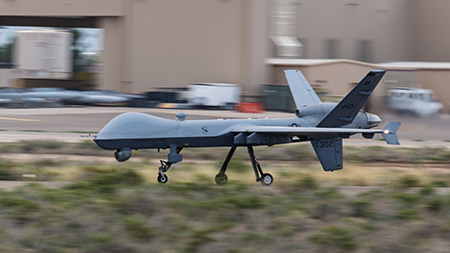Pentagon Pursues ‘High-Low’ Approach to Drone Procurement
October 2025
By Michael T. Klare
In its drive to equip U.S. forces with increased numbers of unmanned weapons systems, the Department of Defense appears to be pursuing a “high-low” approach to procurement, seeking vast numbers of cheap, disposable drones along with fewer numbers of highly capable but more expensive unmanned combat vehicles.

The “low” end of this acquisition strategy was unveiled by Secretary of Defense Pete Hegseth July 10 in a memorandum to senior Pentagon officials on “Unleashing U.S. Military Drone Dominance.” As he indicated, the memo’s aim is to expedite the development, production, and deployment of low-cost drones in massive numbers.
“Drones are the biggest battlefield innovation in a generation,” Hegseth declared in the July 10 memorandum. Yet, “U.S. units are not outfitted with the lethal small drones the modern battlefield requires.”
To overcome this deficit, he called on the military services to rapidly commence large-scale purchases of such devices from U.S. manufacturers, including from start-up companies with little previous experience working with the Pentagon. “We will bolster the nascent U.S. drone manufacturing base by approving hundreds of American products for purchase by our military,”
he wrote.
To facilitate this process, Hegseth decreed in accompanying instructions that small drones, or unmanned aerial systems, be redefined as “consumable commodities” for procurement purposes, simplifying their acquisition by the military. “Small [unmanned aerial systems] resemble munitions more than high-end airplanes,” he stated. “They should be cheap, rapidly replaceable, and categorized as consumable.”
Apparently, on a separate track, the Pentagon and the military services are developing large, unmanned combat vehicles that are the very opposite of what might be termed “cheap, rapidly replaceable, and … consumable.” These include unmanned surface vessels the size of a small, manned corvette and pilotless jet fighters projected to cost tens of millions of dollars each.
In its budget request for fiscal year 2026, for example, the Defense Department sought $1.1 billion for procurement of the Medium Unmanned Surface Vessel, a pilotless, missile-armed warship with a projected length of up to 200 feet. The Navy already has tested several prototypes of the medium unmanned surface vessel, but it may be several years before production of combat-ready vessels will begin. (See ACT, November 2020.)
The 2026 Pentagon budget request also included $789 million for research and development of the Air Force’s Collaborative Combat Aircraft, an unmanned fighter jet intended to serve as a “loyal wingman” to piloted aircraft on high-risk missions. As envisioned by the Air Force, the collaborative combat aircrafts—each governed by AI-enabled flight controls—will be used to seek out enemy interceptors and air-defense systems and, when authorized by the pilot, engage them on their own.
In April 2024, Secretary of the Air Force Frank Kendall told members of a House Appropriations Committee subcommittee that the Air Force planned to acquire up to 2,000 of the unpiloted aircraft at an estimated cost of $25 million to $30 million each, a program that could cost as much as $60 billion. At that time, the service announced that it had chosen two nontraditional defense contractors, Anduril Industries and General Atomics, neither of which had previously received a major award of this size, to build prototype versions of the collaborative combat aircraft.
A contract award for production of combat-ready CCAs is not expected to be announced until sometime in 2026, but development of the two contending prototypes—General Atomics’s YFQ-42A and Anduril’s YFQ-44A—is proceeding apace. The prototype YFQ-42A underwent its first test flight on Aug. 27, and the YFQ-44A’s first flight is expected shortly, according to Inside Defense.
The Navy, too, has begun development of a collaborative combat aircraft-type “loyal wingman.” On Sept. 5, the service revealed that it had awarded contracts to four contractors—Anduril, Boeing, General Atomics, and Northrop Grumman—for “conceptual designs” for a carrier-based autonomous combat plane. Although expected to be similar in many respects to the Air Force’s collaborative combat design, the Navy variant will be designed to take off and land on aircraft carriers.
